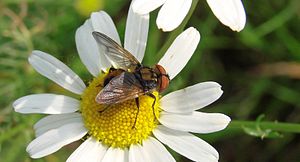Gold shield fly
| Gold shield fly | ||||||||||||
|---|---|---|---|---|---|---|---|---|---|---|---|---|

Goldshell Fly ( Phasia aurigera ) |
||||||||||||
| Systematics | ||||||||||||
|
||||||||||||
| Scientific name | ||||||||||||
| Phasia aurigera | ||||||||||||
| ( Egger , 1860) |
The goldshell fly ( Phasia aurigera ) is a fly from the family of caterpillar flies (Tachinidae). It was insect of the year in 2014 .
features
The fly reaches a body length of 8 to 13 millimeters and, like almost all caterpillar flies, resembles a housefly in its general body shape (to which they are quite closely related). The head has very large, red-colored complex eyes that almost collide in the female, but are separated from each other by about the width of the oculus triangle in the male. The body is predominantly black in color and dusted extensively gray or yellowish. The male is notable for its coloration and drawing: in his case, the mesoscutum (the middle section of the upper side of the trunk) is densely golden-yellow, with two black longitudinal lines (vittae) embedded in it, but they do not reach the rear edge, they are divided into two dark bristle fields. The triangular scutellum behind it is black, sometimes with a yellow tip. The sides of the fuselage are dusted gray. The wings are broadly yellowish to light brown in color. The legs are black or brownish, the rear rails yellow. The abdomen is dark with an extensive yellowish spot on the outside on the fused first two tergites and the front half of the third tergite, in addition, the outside of the fifth tergite is strikingly tinged yellow. The tergites are shiny and not pollinated from the third. The female lacks the striking golden-yellow spot on top of the thorax, and the wings are clear or only very slightly yellow. The male can usually be distinguished from the related species by means of the coloration and drawing: the much more common Phasia hemiptera has no yellow spot, and the side of the rump is noticeably long with reddish-yellow hair. Phasia aurulans also has a yellow spot, but this is limited to the rear end of the postscutum (cf.). A certain determination, especially of the females, is only possible under the microscope, especially according to the characteristics of the bristles. In the female, as in all related species (Phasiinae), the rear end of the abdomen is transformed into a pointed ovipositor.
ecology
The species prefers heat-favored habitats such as dry slopes and warm forest edges. There are two generations a year, the first from the end of May to the end of June, the second, usually more numerous, from mid-August to mid-October. The adults are flower visitors. The lifespan of an imago is around 15 days. The larva parasitizes in species of bugs . The following host species are known: Green stink bug ( Palomena prasina ), gray garden bug ( Rhaphigaster nebulosa ), leather bug ( Coreus marginatus ), juniper edge bug ( Gonocerus juniperi ), Gonocerus acuteangulatus . Hibernation occurs as the first or second larval stage in the host.
distribution
Phasia aurigera is a warmth-loving , Palearctic species, it lives in southern and central Europe, north to the south of France, Germany and Poland. It is also found in the Far East of Russia and in northeast China (an isolated southern record from Sichuan ). In Germany, evidence is available from Bavaria, Baden-Württemberg, Rhineland-Palatinate and Hesse; locally it is not uncommon here. In Poland it is considered endangered
As with many heat-loving species, more recent evidence has been found further north. It seems to have been quite widespread in the Netherlands since around 2005 and also occurs in Denmark but is still absent in Great Britain today .
Taxonomy
The genus Phasia comprises 75 species worldwide, eight of which are found in Central Europe. The species was first described by Egger in 1860 as Alophora aurigera , based on material collected by Ignaz Rudolph Schiner . The type locality is the area around Vienna.
literature
- James E. O'Hara, Shima, Hiroshi; Zhang, Chuntian: Annotated Catalog of the Tachinidae (Insecta: Diptera) of China . (PDF) In: Magnolia Press (Ed.): Zootaxa . 2190, Auckland, New Zealand, 2009, ISSN 1175-5334 , p. 135. Retrieved April 5, 2011.
- Fauna Europaea version 2.4 . European Commission. last update 27 January 2011. Retrieved on April 5, 2011.
Individual evidence
- ↑ a b c d e Xuekui Sun, Marshall, Stephen A .: Systematics of Phasia Latreille (Diptera: Tachinidae) . In: Magnolia Press (ed.): Zootaxa . 276, Auckland, New Zealand, 2003, ISSN 1175-5334 , pp. 71-73.
- ↑ a b Theo Zeegers (2010): Tweede aanvulling op de naamlijst van Nederlandse sluipviegen (Diptera; Tachinidae). Nederlandse Faunistische Mededelingen 34: 55-66. download
- ↑ a b c Hans-Peter Tschorsnig and Benno Herting (1994): Die Raupenfliegen (Diptera: Tachinidae) Central Europe: Identification tables and information on the distribution and ecology of the individual species. Stuttgart Contributions to Natural History Series A (Biology) 506: 1-170. download
- ^ Polish Red Data Book of Animals online
- ↑ Gylden Pragtsnylteflue, Danish Bird og Nature
- ^ Tachinid recording scheme
- ^ Benno Herting: Revision of the European tachinids and rhinophores (Diptera) described by J.Egger, JRSchiner, F.Bauer and JEBergenstamm. In: Natural History Yearbook of the City of Linz. Volume 20, 1974, pp. 129-145 ( PDF on ZOBODAT ).